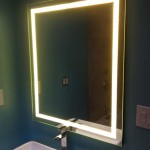Why Do We Prefer Convex Mirrors As Rear View Mirrors?
The ubiquitous presence of convex mirrors as rearview mirrors in vehicles is not accidental. Their use stems from a critical need for enhanced road safety, achieved through the distinct optical properties of these curved reflectors. Understanding why convex mirrors are preferred requires a deeper examination of their unique characteristics compared to plane (flat) and concave mirrors.
A core advantage of convex mirrors lies in their wider field of view. The outward curvature causes light rays to diverge, effectively expanding the reflected scene. This allows drivers to see a larger portion of the road behind them, including vehicles in adjacent lanes and potential hazards that might be missed with a narrower field of view. This expanded perspective is crucial for safe lane changes, merging, and general situational awareness.
The image formed by a convex mirror is always virtual, upright, and diminished. While the smaller image size might seem counterintuitive, it is this very characteristic that contributes to the wider field of view. By shrinking the reflected image, the mirror can encompass a larger area within its frame. This trade-off between image size and field of view is considered advantageous for rearview mirrors, as the primary goal is to provide a broad overview of the rear surroundings rather than a detailed view of individual objects.
In contrast, plane mirrors, while offering accurate size and distance representation, provide a limited field of view. Their flat reflective surface reflects light rays without altering their path, resulting in an image that is the same size and distance as the object but covers a narrower area compared to a convex mirror. This restricted view can create blind spots, increasing the risk of accidents, particularly during lane changes or reversing.
Concave mirrors, on the other hand, converge light rays to a focal point. This convergence can produce magnified and inverted images, depending on the object's distance from the mirror. While useful in certain applications like telescopes and makeup mirrors, these characteristics are undesirable for rearview mirrors. The magnified image would reduce the field of view significantly, making it difficult to see the overall traffic situation. Furthermore, the potential for inverted images at certain distances adds unnecessary complexity and could lead to misinterpretations of the scene behind the vehicle.
The term "diminished image" in the context of convex mirrors often leads to misconceptions. It's crucial to understand that the smaller image doesn't necessarily mean objects appear further away than they are. While the size reduction might contribute to this perception, the primary factor affecting distance judgment is experience and contextual clues. Drivers quickly adapt to the image characteristics of convex mirrors and learn to accurately estimate distances based on the relative size and position of objects in the reflected scene.
The inscription often found on passenger-side rearview mirrors, "Objects in mirror are closer than they appear," serves as a cautionary reminder of the diminished image effect. This warning is particularly relevant for the passenger-side mirror, as the greater distance to objects on that side, combined with the image reduction, can lead to underestimations of their proximity. This cautionary message promotes safer maneuvering and discourages sudden lane changes without proper checking of blind spots.
The curvature of a convex mirror is a carefully considered design aspect. A highly curved mirror provides an extremely wide field of view but significantly reduces the size of reflected objects, making distance estimation more challenging. Conversely, a mirror with minimal curvature offers a narrower field of view but a larger image size. The optimal curvature balances the need for a broad perspective with the requirement for reasonably sized images that facilitate distance judgment. Automotive engineers carefully select the curvature to maximize safety and driver awareness.
The use of convex mirrors as rearview mirrors is a result of a thorough evaluation of optical principles and their application to road safety. Their ability to provide a wide field of view, albeit with a diminished image, significantly enhances driver awareness and reduces blind spots, contributing to safer driving conditions. This understanding of the benefits of convex mirrors explains their widespread adoption as a crucial safety feature in vehicles worldwide.

4 Why Do We Prefer A Convex Mirror As Rear View In Vehicles Class10

Why Do We Prefer Convex Mirror As A Rear View In Vehicles Class 10 Ch Light Physics

4 Why Do We Prefer A Convex Mirror As Rear View In Vehicles Pg 16

Concave Mirror Why Do We Prefer A Convex As Rear View In

Solved Why Do We Prefer A Convex Mirror As Rear View In Vehicl

Could U Pls Ans This Question4 Ii Why Do We Prefer A Convex Mirror As Rear View In Science Light Reflection And Refraction 13356289 Meritnation Com

Q 3 Name A Mirror That Can Give An Erect And Enlarged Image Of Object

Solved Answer The Questions Please As Directed 2 M Why Do We Prefer Convex Mirrors Rear View In Vehicles Find Focal Length Of A

Since Power Of The Lens Is Positive Or Focal Length Pos

Why Do We Prefer A Convex Mirror As Rear View In Vehicles








